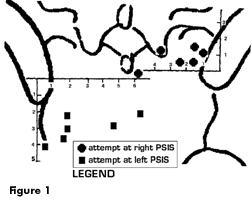In 1990, Hessel et al.,2 measured the forces produced by two chiropractors on each of six patients. They used a drop-table assisted HVLA thrust intended to impact upon the PSIS. To put the matter simply, they attempted to correct something that sounds like a PI ilium using an adjustive procedure attributed to the Thompson technique. Each subject received three thrusts from both chiropractors (a total of six), with two minutes between thrusts and 20 minutes between chiropractors.
The investigators measured five parameters: preloading force; peak force; duration of manipulation; impulse of manipulation; and point of application of the peak force. Although all the data were interesting and mostly consistent with the results of previous studies, I would like to draw attention to just one of the experimental findings:
"The location of the point of application of the peak force relative to a low back reference system appeared to be very consistent. However, it was not on the posterior superior iliac spines (PSIS) as expected, but always slightly medial to this point."
Let's see: The peak force was always (my emphasis) produced "slightly" medial to the PSIS. Slightly? As can be seen in Figure I, the doctors missed the PSIS by 1 to 6 cm, by an average of about 3 cm, landing all over the sacral base! By any theory of the PI ilium, surely it must be a matter of some consequence to consistently slip medially off the contacted PSIS and wind up thrusting on the sacrum.
[Figure I: Each of 12 attempts to adjust the PSIS impacted on the sacrum instead. Based on data from Hessel (Hessel 1990, #145).]
Logan opined that the sacral base tended to subluxate anteroinferiorly when the innominate bone rotated posteriorly.
Drop-table practitioners like Thompson3 and Stillwagon4 would agree with Logan,5 as would most Activator methods doctors and many Diversified practitioners. I also agree, and have reasons to suspect6 that the sacral base unilaterally nutates when the innominate bone cleaves posteriorly (Hildebrandt's term7), winding up anterior (if not inferior) to the ipsilateral innominate. It is troubling in this study that a commonly used adjusting method designed to correct a sacroiliac fault believed to be associated with an anterior sacrum actually would drive the sacral base more anterior. (Nonetheless, none of the subjects in the study were reported to have been made worse by these apparently misdirected thrusts.)
Let us list a few possible interpretations of these results:
• The experiment was flawed in some way, so that the segmental impact points were not accurately measured.
• The two doctors were more careless with their segmental contact points than are most chiropractors, so the outcome is not generalizable.
• Although the type of adjustment used in this study is prone to miss its intended segmental contact, most other adjustive styles are more segmentally accurate. (Sure.)
• Even though the segmental contact point was wrong, the sacroiliac joint may benefit in some way, perhaps by correcting on the rebound (a phrase frequently invoked to explain the most curious of chirophenomena!).
• The fundamental entity addressed by HVLA thrusting is fixation, faulty neurology, pain perception, etc. but not really misalignment, so being off the segmental contact point is not of major significance.
The last two interpretations, in particular, imply that segmental specificity in the contact point may not be as important as is commonly suggested. Nonetheless, many chiropractors feel that the only thing that separates their profession from that of the common domain manipulators is precisely this emphasis on specificity. A few have in their writings gone so far as to bet the family farm (incidentally, our family farm) on that belief. Perhaps this was not a very good idea, or at least it was an idea that needs to be amended at this time.
Although one would not want to overinterpret the results of just one experiment, a drop in the clinical bucket, these data appear to be consistent with the longest running, largest scale research project ever conducted by chiropractors. I am referring to the cumulative result of dozens, if not hundreds, of interexaminer reliability experiments investigating practically every analytic/diagnostic commonly used by chiropractors: motion palpation, thermography, manual muscle testing, leg checking and more. These largely negative studies convincingly demonstrate that specific chiropractic examination findings are often randomly generated. According to Bogduk, the situation in orthopedic medicine is essentially the same: "Physical examination is a traditional ritual that physicians practice using techniques of assumed reliability and validity. The available data on the science of clinical examination for spinal pain indicates that diagnosis is based essentially on guesswork."8
This lack of diagnostic specificity is merely the flip side of the lack of adjustive specificity found in the Hessel study. The net result of all this is that in a typical clinical scenario, about equal proportions of chiropractors are addressing the "right" and "wrong" things. There is a roughly equal likelihood of getting the right diagnosis but addressing the wrong segment, and getting the wrong diagnosis but addressing the right segment (assuming, of course, there really is a "right" segment).
The news is not all bad. There are no data suggesting that chiropractic patients are routinely made worse by care, and by most accounts chiropractic is extremely safe and effective for the most typical patient complaints. It follows that interventions are better viewed not so much as right or wrong as more or less effective. Doing the right thing is probably better than doing the wrong thing, and doing the wrong thing is probably better than doing (literally) no thing.
If both diagnostic and adjustive specificity is more a question of intent than reality, then the old cliche, "Give the right adjustment at the right place and at the right time" is not only baseless, but potentially dangerous to the long term success of the chiropractic procession. It provides no explanation of how an adjustive procedure may benefit patients in spite of specificity failure, and leads only to the sad conclusion that any such benefits must be all a matter of placebo. All the chatter about the dire consequences of adjusting nonsubluxated segments only makes it worse, by inexorably forcing us to conclude that about half the time we actually hurt patients by adjusting inappropriate segments, whether out of diagnostic or adjustive specificity failure. I think not.
Since future experiments (e.g., Hessel et al.2) may further erode the importance of segmental specificity, it may be wise to develop a subluxation model that goes beyond pure segmentalism, the chiropractic approach that most clearly demands segmental specificity. Perhaps chiropractors would be better served by subluxation models that acquire information more from a wide lens camera more than a microscope.
Chiropractic structuralism, generally attributed historically to Willard Carver9 and today carried on by Harrison, Pettibon and others, is just such an approach. My own introduction to it was during my chiropractic education, thanks to professor John Stiga. He once wrote: "Posture is an order or dimension of description that is simpler than bony misalignments, distorted discs and ligaments, restricted range of motion and aberrant end play in joints, taut and flaccid muscles and tendon reflexes, and various soft-tissue indicators. Yet, it collects all of these as a general total."10
Chiropractors would be well served to develop global approaches that depend more on easily measured examination findings such as ROM and postural assessment. They should also better appreciate that orthopedic examination is not merely a question of achieving a "medical" diagnosis, or of ruling out contraindications to thrusting, but directly provides indicators on how best to adjust. The clinical interventions that follow from such global measurements and orthopedic exam findings are inherently regional in character. I call them "vectored manipulations" for want of a better term: carefully formulated and structurally informed regional approaches to regional problems that subsume segmental faults automatically.
Of course, it is not a matter of choosing between the segmentalist and structuralist approaches to chiropractic technique, but of trying to decide for any given patient, based on the history and exam findings, which approach makes more sense. Some patients may suffer primarily from truly segmental faults, whereas others from a more regional problem that simply generates signs and symptoms at various locations. Drawing the distinction in a particular case is far from straightforward. I do not claim to have all the answers, but one thing is almost certain: If chiropractors do not start backing off from their segmental specificity uber alles mentality, they could find themselves in some terrible trouble some day. Diagnostic segmental specificity is already discredited, and experiments like the one herein described may thoroughly discredit adjustive segmental specificity. If chiropractors can't explain their claimed good results in some way -- and what's worse, if they continue to engage in petrified thought by defending a model that predicts bad results when there is specificity failure -- then competing professions will be only too happy to provide alternative interpretations that chiropractors will not relish.
References
- Cooperstein R. On wedge angles and stuff. Dynamic Chiropractic 1998;17(1):9,17,26.
- Hessel BW, Herzog W, Conway PJW, et al. Experimental measurement of the force exerted during spinal manipulation using the Thompson technique. Journal of Manipulative and Physiological Therapeutics 1990;13(8):448-453.
- Thompson C. Thompson Technique Reference Manual, 1st ed. Elgin, IL: Thompson Educational Workshops, Williams Manufacturing, 1974.
- Stillwagon G, Stillwagon KL. The Pierce-Stillwagon technique. American Chiropractor 1983(July/August):20-23,28-31,65.
- Logan HB. Textbook of Logan Basic Methods. St. Louis, MO: unknown, 1950.
- Cooperstein R. Chiropraxis. Oakland, CA: self-published, 1994.
- Hildebrandt RW. Chiropractic Spinography, 2nd ed. Baltimore: Williams & Wilkins, 1985.
- Cooperstein R. ABS meets in San Francisco: part II. Dynamic Chiropractic 1998;16(7):27,32-34.
- Rosenthal MJ. The structural approach to chiropractic: from Willard Carver to present practice. Chiropractic History 1981;1(1):25-29.
- Stiga J. Postural chiropractic. Today's Chiropractic 1984 (August):9-11.
Click here for previous articles by Robert Cooperstein, MA, DC.






